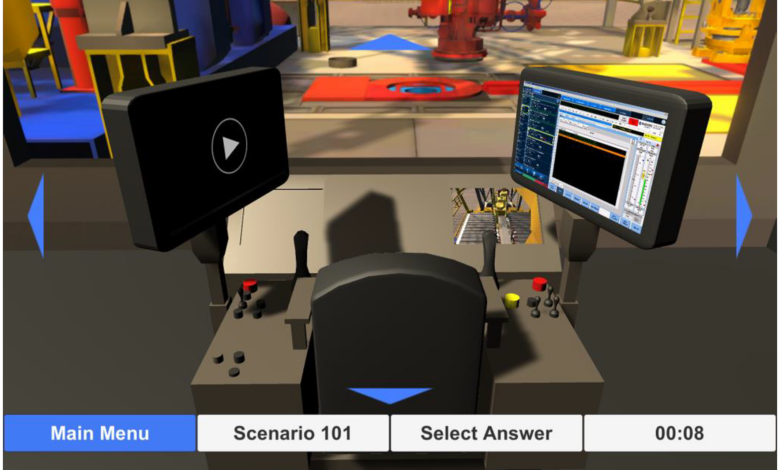Nabors adds scenario-based simulator exercises to training program for new drillers
As rigs become more automated, new training was needed to ensure drillers’ knowledge kept pace with evolution in rig control systems


By Stephen Whitfield, Associate Editor
Drillers work in high-hazard environments managing dynamic situations. They look after multiple ongoing tasks within increasingly complex rig control systems and have to quickly respond to potentially hazardous situations. As rigs come to rely more on automation and digital tools, the driller’s familiarity with the rig control systems becomes even more important for maintaining safety and improving performance.
“Everything is time critical on the rig,” said Malini Manocha, Director of the Center of Excellence at Nabors Industries. “There are close to 1,300 HMI (human-machine interface) screens that the driller needs to know in and out, and there are also performance-based tools that have to be managed, and automation systems put in front of him. You have to seamlessly move around these screens easily.”
In this environment, Nabors has turned its focus to providing cutting-edge training for its workforce focused on today’s sophisticated rig control systems, ensuring that they have the competencies needed to manage such complex technologies. Recently, this work involved the use of rig simulation software that puts drillers through different scenarios they have to resolve – including scenarios that are difficult to re-create on a drilling rig or in a classroom.
Speaking at the 2023 SPE/IADC International Drilling Conference in Stavanger, Norway, on 9 March, Ms Manocha outlined Nabors’ work in developing scenario- and simulator-based training that drillers can take anywhere in the world. Launched in February 2022, the program trains drillers using simulated scenarios that are based on real-world incidents, such as those caused by drilling dysfunctions and equipment failures. While this type of training does not replace in-person training, Ms Manocha said it is an additional tool in the toolbox.
“The integration of these simulator-based, real-world exercises allows us to deep dive further into our rigs’ control systems,” she said. “They give us a better understanding of the software we use for optimizing drilling performance, of safety on the rig and of process automation, which is very critical for our drillers to succeed.”
Simulating responses to real-world events
The simulation software has a server-based architecture, so each trainee can login remotely from wherever they are. It uses a hardware-in-the-loop programmable controller – hardware-in-the-loop is a technique where real signals from a controller are connected to a test system that simulates reality, essentially tricking the controller into thinking it is in the simulated rig. That controller is integrated with physics-based models for drilling hydraulics, drilling dynamics, directional drilling and various physical equipment on the rig, allowing the trainer to re-create real situations on the rig.
The drilling simulator was designed to complement, not replace, Nabors’ other training methods, Ms Manocha emphasized. Prior to training on the simulator, drillers-in-training are still required to shadow a driller on a working rig, as well as attend in-person specialized training around the rig control systems. After that, they can undertake this two-day course on the simulator, working with trainers to go through exercises built around hazardous scenarios, equipment failures and drilling dysfunctions. Trainers are available during the exercises to provide instructions and feedback.
A sample exercise Ms Manocha discussed during her presentation was an equipment failure scenario related to the drawworks encoder, a sensor whose output often has to be calibrated by the driller. A malfunctioning drawworks encoder can lead to incorrect depth tracking and the inability to determine the speed and direction of the drawworks. In the simulator, the trainer can send a command triggering an encoder failure and – like in the real world – a subsequent alarm in the rig control system. The exercise involves the trainee working to identify the cause of the fault – which is set by the trainer – and respond appropriately.
The drawworks encoder failure is one of 70 equipment-related dysfunctions built into the simulator. There are also several well dysfunction scenarios around lost circulation, washout, kick injection, plugged jet and bit wear. “We can take scenarios from our actual rigs and replay them in the simulator’s scenario management system, so the driller can actually see how to respond to it and get a feel for the amount of time he needs to respond to it. This has been really effective in training on more complex operations,” she said.
At the end of the training course, a test for the trainees involves resolving various scenarios under a predetermined time limit. The driller’s response to the dysfunctions and scenarios are measured and formulated into a competency assessment matrix, which allows the trainers to determine if additional training is needed. The time component is new to the simulator-based training, as the company previously measured only knowledge of the training material. “Our rig systems are changing, and you need to be able to adapt. You need to be able to monitor, perform and respond very quickly because everything is so very time critical,” Ms Manocha said.
After working with the trainers in the program, trainees can also continue training on their own by accessing scenarios stored on the server using mobile devices. The simulator, not a trainer, walks trainees through the exercise to help them identify and solve the problem presented. The simulator will also pose questions to the trainee on various aspects of the scenario during the training; in case of an incorrect answer, the simulator will show the correct answer.
Ms Manocha said the individual training programs are designed to help reinforce the lessons learned in the initial training course. “We all know that learning is a continuous process. We want to continuously challenge the drillers as they’re going along, keep introducing scenarios and best practices.”
Evaluating training effectiveness
Nabors recorded 720 hours of training on the simulator during its testing period, which took place from February to April 2022, with the bulk of trainees coming from the US, Saudi Arabia and Argentina. Both trainers and trainees were later surveyed to help Nabors assess the effectiveness of the program.
Results show the trainers found the scenario-based training to be valuable. Although some trainers said they still preferred face-to-face training, they also said the new simulator-based program helped improve driller competency compared with classroom-only training.
Trainees were asked about their confidence in performing their job after the training and how they felt the training had developed their skills, attitudes and knowledge. The trainees strongly agreed the training helped them understand rig control systems and that they were able to navigate HMIs post-training.
As far as how the program was able to change trainees’ behavior, both trainees and trainers said they believe the training improved the driller’s quality of operations and made the driller aware of the consequences of not following process and procedure.
Proving the program was a good investment, trainers also noted other improvements, such as more trainees passing their competency assessment without needing additional training.
Following the pilot period, the simulator courses were added to Nabors’ training protocol for new drillers.
The company is also working to add more capabilities, such as additional models to cover stick-slip, interbedded formations and buckling effect scenarios. On the question of evolving the training program to a peer led driller training program, Ms. Manocha said that the driller training was “primarily a trainer-trainee program.”
“There are some advantages to that, because the trainer can walk you through things. But once you’ve gone through that training, that’s something where you could possibly have a peer-led program program in the future where drillers can play various scenarios, compete with each other on different scenarios, trying to get better, and you can comment and say something like, ‘Hey, this isn’t how I handle this situation.’ There are a lot of ways in which this program can evolve.” DC
More information is available in SPE 212551, “Scenario-Based Training in Drilling Rig Simulator Improves Drillers Core Competency.”




